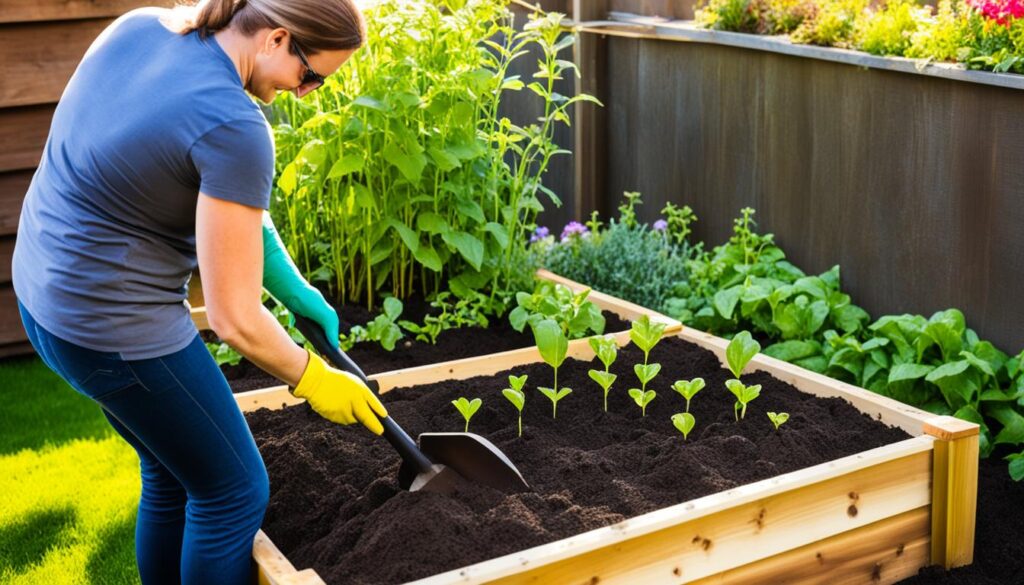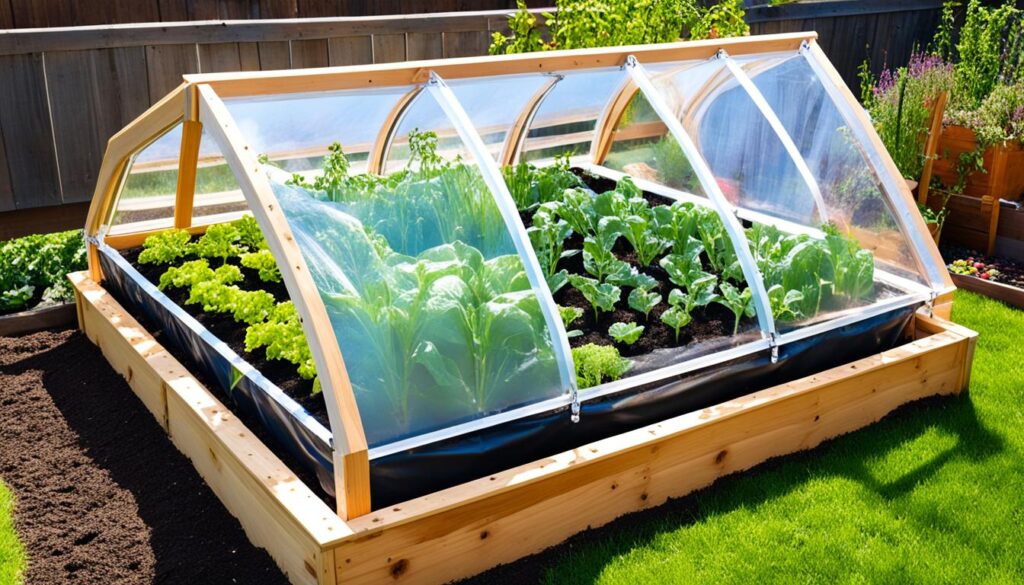Hello, gardening enthusiasts! Today, I am here to address a burning question – Can indoor chrysanthemums be planted outside? Many of us love the vibrant charm of these beautiful flowers and would like to extend their blooms into our outdoor gardens. In this article, I will delve into the feasibility of transplanting indoor chrysanthemums to the great outdoors and provide valuable tips on ensuring their successful growth. So, let’s dive right in!
Key Takeaways:
- Indoor chrysanthemums can be successfully transplanted to the outdoor garden.
- Consider factors such as climate, sunlight, and space requirements before moving indoor chrysanthemums outside.
- Prepare indoor chrysanthemums for outdoor planting by repotting and acclimating them to the new environment.
- Choose the right location in your garden, providing adequate sunlight, well-drained soil, and sufficient space for growth.
- Proper care, including watering, fertilizing, and pest protection, is essential for the health and longevity of outdoor chrysanthemums.
Understanding Chrysanthemum Planting Options
When it comes to planting chrysanthemums outdoors, there are various options to consider. Whether you’re a seasoned gardener or a beginner, understanding the different planting techniques and care requirements can help ensure the success of your chrysanthemums in an outdoor setting.
One popular method is to plant chrysanthemums directly in the ground. This allows the roots to establish themselves in the soil, providing stability and access to nutrients. Before planting, it’s important to prepare the soil by loosening it and removing any rocks or debris. Chrysanthemums prefer well-drained soil, so adding organic matter such as compost can improve soil structure and drainage. Plant the chrysanthemum at the same depth as it was in its nursery pot, ensuring that the crown is above the soil level.
If you have limited garden space or poor soil conditions, container gardening is a fantastic alternative. Planting chrysanthemums in containers offers flexibility and allows you to move the plants around to suit your preferences. Choose a container with drainage holes and fill it with a high-quality potting mix. Make sure the container is large enough to accommodate the root system of the chrysanthemum, and place it in a location that receives at least six hours of sunlight per day.
Another option for planting chrysanthemums is using raised beds. Raised beds provide better drainage and prevent soil compaction, leading to healthier plants. To create a raised bed for your chrysanthemums, build a frame using untreated wood or stone materials. Fill the bed with a mixture of compost, topsoil, and sand to create a well-draining growing environment. Raised beds are particularly beneficial if you have heavy clay or poorly drained soil.
Caring for Outdoor Chrysanthemums
Once you’ve chosen the planting option that suits your needs, it’s essential to provide proper care for your outdoor chrysanthemums. These gardening tips will help you keep your chrysanthemums healthy and thriving:
- Watering: Chrysanthemums require regular watering to thrive. Keep the soil consistently moist but not waterlogged. Water at the base of the plant to avoid wetting the foliage, as this can lead to diseases.
- Fertilizing: Feed your outdoor chrysanthemums with a balanced fertilizer. Apply a slow-release fertilizer in spring, and supplement it with liquid fertilizer every few weeks during the growing season.
- Pruning: To encourage bushiness and more abundant blooms, pinch back the tips of the chrysanthemum stems when they reach about six inches in height. Additionally, remove any dead or faded flowers regularly to promote continuous blooming.
- Protection: Outdoor chrysanthemums may be vulnerable to pests such as aphids or diseases like powdery mildew. Regularly inspect your plants for any signs of infestation or infection and take prompt action to treat the issue.
- Winter care: Chrysanthemums are perennials in some regions, but in colder climates, they may need protection during winter. Mulch around the base of the plant with straw or leaves to insulate the roots from freezing temperatures.
By understanding the different planting options and implementing proper care techniques, you’ll be well on your way to cultivating beautiful chrysanthemums in your outdoor garden. With their vibrant colors and stunning blooms, these captivating flowers are a delightful addition to any landscape.
Assessing the Feasibility of Transplanting Indoor Chrysanthemums
When considering moving your indoor chrysanthemums outside, it’s important to assess the feasibility of this decision. Transplanting indoor plants to an outdoor garden can be a rewarding experience, but it requires careful consideration of several factors.

Climate
First and foremost, you need to evaluate the climate in your area. Chrysanthemums thrive in cooler climates with temperatures ranging from 50°F to 75°F (10°C to 24°C). If your region experiences extreme heat or cold, it may not be suitable for outdoor cultivation. Consider the average temperature and the potential for frost or heatwaves in your locality.
Sunlight
Another crucial factor to assess is the amount of sunlight your outdoor space receives. Chrysanthemums require at least 6 hours of direct sunlight per day to bloom and flourish. Observe your garden throughout the day to determine if it receives adequate sunlight. If your outdoor area is heavily shaded, it might not be the ideal environment for your chrysanthemums.
Space Requirements
Chrysanthemums have different space requirements based on their variety. Some varieties can spread and take up a significant amount of space in your garden, while others grow more compactly. Evaluate the available space in your garden and ensure it can accommodate the size of your chrysanthemum plants.
Before moving your indoor chrysanthemums outside, consider these factors carefully. Assess the climate conditions, sunlight exposure, and space availability in your outdoor garden. By making an informed decision, you can provide the best possible environment for your chrysanthemums to thrive outdoors.
Preparing Indoor Chrysanthemums for Outdoor Planting
When it comes to transitioning indoor chrysanthemums to the great outdoors, proper preparation is key for their successful growth. Here, I will provide step-by-step instructions on how to prepare your indoor chrysanthemums for outdoor planting, ensuring they thrive in their new environment.
1. Repotting
Before moving your chrysanthemums outdoors, it’s essential to repot them into larger containers. Choose a well-draining potting mix that is suitable for outdoor use and gently remove the plant from its current container. Carefully loosen the roots and place the chrysanthemum into the larger pot, ensuring it is at the same depth as it was before. Fill the remaining space with the potting mix, firming it gently around the plant.
2. Gradual Acclimatization
Indoor chrysanthemums need time to adjust to the different environmental conditions they will encounter outdoors. Start by placing them in a shaded area of your garden for a few hours each day, gradually increasing their exposure to sunlight over a period of two weeks. This will help prevent shock and ensure a smoother transition.
3. Soil Preparation
Prior to planting your chrysanthemums outdoors, prepare the soil in the chosen garden bed. Ensure the soil is well-draining and amend it with organic matter such as compost or well-rotted manure. This will provide essential nutrients and improve drainage, promoting healthy growth.
4. Planting
When planting your chrysanthemums outdoors, dig a hole slightly larger than the root ball of the plant. Gently place the chrysanthemum into the hole, ensuring it is at the same depth as it was in the pot. Backfill the hole with soil, firming it gently around the plant to remove any air pockets. Water the newly planted chrysanthemums thoroughly to settle the soil.
5. Environmental Considerations
Outdoor conditions can be more challenging for chrysanthemums compared to their indoor environment. Ensure your plants receive sufficient water, but avoid overwatering, as this can lead to root rot. Provide support for taller varieties to prevent them from bending or breaking in strong winds. Additionally, monitor for pests and diseases, and take appropriate measures to protect your plants.
By following these steps and giving your indoor chrysanthemums the proper care during their transition, you can enjoy their beautiful blooms outdoors and enhance your garden with their vibrant colors.
Best Time to Plant Chrysanthemums Outdoors
When it comes to planting chrysanthemums outdoors, timing is key. To ensure the success of your chrysanthemums, it’s important to consider the specific requirements of different varieties and the climate in the UK.
In general, the best time to plant chrysanthemums outdoors is in the spring, after the threat of frost has passed. This allows the plants to establish themselves before the hot summer months.
However, if you’re looking to enjoy chrysanthemums in full bloom during the autumn, you can also plant them in early summer. This will give the plants enough time to grow and develop before they start blooming in the cooler months.
In terms of the specific months, April and May are often considered ideal for planting chrysanthemums outdoors. This allows them to take advantage of the spring’s moderate temperatures and abundant rainfall.
Before planting, make sure to prepare the soil by incorporating organic matter and ensuring good drainage. Chrysanthemums prefer well-draining soil and can struggle in heavy clay or waterlogged conditions.
Remember, different varieties of chrysanthemums may have slightly different planting requirements, so it’s always a good idea to check the specific guidelines for the variety you’ve chosen.
Tips for planting chrysanthemums outdoors:
- Choose a sunny location for your chrysanthemums, as they thrive in full sun.
- Provide adequate spacing between plants to allow for proper air circulation.
- Water chrysanthemums regularly, ensuring the soil remains moist but not waterlogged.
- Apply a balanced fertilizer at the time of planting and throughout the growing season.
- Monitor for pests and diseases and take appropriate measures to protect your plants.

By following these planting guidelines and caring for your chrysanthemums throughout the growing season, you can enjoy a beautiful display of vibrant flowers in your outdoor garden.
Choosing the Right Location for Outdoor Chrysanthemums
When it comes to planting chrysanthemums in your outdoor garden, selecting the right location is crucial for their growth and overall health. By considering factors such as sunlight, soil quality, and drainage, you can create an optimal environment for these beautiful flowers to thrive.
Sunlight Requirements
Chrysanthemums are sun-loving plants and require at least six hours of direct sunlight each day to bloom abundantly. When choosing a location for your outdoor chrysanthemums, look for an area that receives ample sunlight throughout the day. Avoid areas that are heavily shaded by trees or buildings, as insufficient sunlight can lead to weak growth and fewer flowers.
Soil Quality
Ensuring the soil quality is essential for the successful growth of chrysanthemums. These flowers thrive in well-draining soil that is rich in organic matter. Before planting, prepare the soil by incorporating compost or well-rotted manure to improve its fertility and drainage. Additionally, avoid areas with heavy clay soil or those prone to waterlogging, as this can cause root rot and other harmful conditions for your chrysanthemums.
Drainage
Proper drainage is critical for the health of outdoor chrysanthemums. Excess moisture can lead to root rot and other fungal diseases. To ensure adequate drainage, avoid planting chrysanthemums in low-lying areas or areas prone to waterlogging. If necessary, consider creating raised beds or mounds to improve drainage and prevent water from pooling around the plants.
By taking these factors into account and choosing the right location in your garden, you can provide the optimal conditions for your outdoor chrysanthemums to thrive. The next section will delve into the basic care tips that can further enhance the growth and blooming of your chrysanthemums.
Basic Care Tips for Outdoor Chrysanthemums
Once you’ve successfully planted your chrysanthemums in your outdoor garden, it’s important to provide them with the care they need to thrive. Here are some essential tips for outdoor chrysanthemum care:
1. Watering:
Keep the soil consistently moist but not waterlogged. Water your chrysanthemums regularly, especially during dry spells. Water at the base of the plant to avoid wetting the leaves, which can lead to diseases.
2. Fertilizing:
Feed your outdoor chrysanthemums with a balanced, slow-release fertilizer in early spring and mid-summer. This will provide the nutrients they need to produce healthy flowers. Follow the fertilizer manufacturer’s instructions for application rates.
3. Pruning:
Regularly pinch back the tips of the chrysanthemum stems to encourage bushier growth. This can be done by simply using your fingers or pruning shears to remove the top few inches of growth. Additionally, deadhead any faded flowers to promote continuous blooming.
4. Pests and Diseases:
Monitor your chrysanthemums for pests such as aphids, mites, and caterpillars. Use organic insecticides or insecticidal soaps if necessary. It’s also important to keep the garden area clean and free from debris to prevent the spread of diseases, such as powdery mildew or leaf spot.

5. Winter Protection:
Before the winter season arrives, apply a layer of mulch around the base of your chrysanthemum plants. This will provide insulation and protect the roots from freezing temperatures. Consider using straw, shredded leaves, or wood chips as mulch.
By following these basic care tips, you can ensure that your outdoor chrysanthemums remain healthy and vibrant throughout the growing season. With proper care, these beautiful flowers will bring joy and color to your garden.
Overwintering Outdoor Chrysanthemums
When it comes to outdoor chrysanthemum care, proper overwintering is crucial to ensure the survival of these beautiful flowers. In this section, I will provide you with valuable gardening tips for chrysanthemums in the colder months.
Pruning
Pruning outdoor chrysanthemums is essential before the arrival of winter. Cut back the stems to around 4-6 inches above the ground after the first frost. This will help the plant conserve energy and protect it from cold weather damage. Remember to remove any dead or diseased stems as well.
Mulching
Mulching is an effective technique for protecting chrysanthemums throughout the winter. After pruning, apply a thick layer of organic mulch, such as straw or wood chips, around the base of the plant. This insulation will help regulate soil temperature and prevent frost heave, which can cause damage to the plant’s roots.
Protection against Frost
Frost is one of the biggest threats to outdoor chrysanthemums during winter. To protect your plants, cover them with frost blankets or horticultural fleece when frost is expected. Alternatively, you can create a temporary shelter using stakes and clear plastic sheeting. Remember to remove the covers during the day to allow sunlight to reach the plants.
By following these outdoor chrysanthemum care tips, you can ensure that your plants survive the winter and bloom beautifully again in the spring. In the next section, we’ll discuss troubleshooting common issues that may arise when growing outdoor chrysanthemums.
Troubleshooting Common Issues with Outdoor Chrysanthemums
When it comes to outdoor chrysanthemum care, various challenges can arise. However, with the right gardening tips for chrysanthemums, you can address these common issues and ensure the health and vitality of your outdoor chrysanthemum plants. Here are some common problems you may encounter and their respective solutions:
Poor Flowering
If your outdoor chrysanthemums are not flowering as expected, inadequate sunlight or improper pruning may be the cause. Ensure that your plants receive at least six hours of direct sunlight daily. Additionally, remember to pinch back the stem tips by one or two inches in early summer to encourage lateral branching and promote more blooms.
Yellowing Leaves
Yellowing leaves can be a sign of overwatering or nutrient deficiencies. Make sure that your outdoor chrysanthemums are planted in well-draining soil and water them only when the top inch of soil feels dry to the touch. Consider using a balanced slow-release fertilizer to provide the necessary nutrients for healthy leaf growth.
Pest Infestation
Common pests that can affect outdoor chrysanthemums include aphids, caterpillars, and slugs. To combat aphids, try spraying a mixture of water and mild soap on the affected areas. For caterpillars, manually remove them from the plant or use an organic insecticide. To control slugs, create barriers made of crushed eggshells or apply diatomaceous earth around the base of your chrysanthemums.
Fungal Diseases
Fungal diseases such as powdery mildew and botrytis can affect outdoor chrysanthemums. To prevent powdery mildew, ensure good airflow around your plants and avoid overhead watering. If botrytis occurs, remove any affected plant material and improve air circulation to minimize the spread. Applying a fungicide recommended for chrysanthemums may also help control these diseases.
By being proactive in troubleshooting common issues with outdoor chrysanthemums, you can ensure the longevity and beauty of your garden. Remember to regularly inspect your plants for signs of problems, provide proper care, and promptly address any challenges that arise.
Conclusion
In conclusion, this article has explored the feasibility of transplanting indoor chrysanthemums to the outdoor garden and provided comprehensive guidance on their care and maintenance in an outdoor setting. By following the tips and guidelines outlined in this article, you can successfully plant chrysanthemums outdoors and enjoy their vibrant blooms in your garden.
When considering whether indoor chrysanthemums can be planted outside, it is essential to ensure that the plants are acclimated gradually to the outdoor environment, taking into account factors such as climate, sunlight, and space requirements. Proper preparation, repotting, and choosing the right location are key steps in setting the stage for healthy growth and development.
Once planted outdoors, chrysanthemums require regular care, including watering, fertilizing, and protection against pests and diseases. Overwintering chrysanthemums also plays a vital role in their long-term survival, and proper pruning, mulching, and frost protection measures are necessary.
With proper knowledge and attention to their unique needs, you can successfully plant and maintain outdoor chrysanthemums, adding beauty and color to your garden. So go ahead and bring the natural elegance of chrysanthemums beyond your doorstep with confidence!








